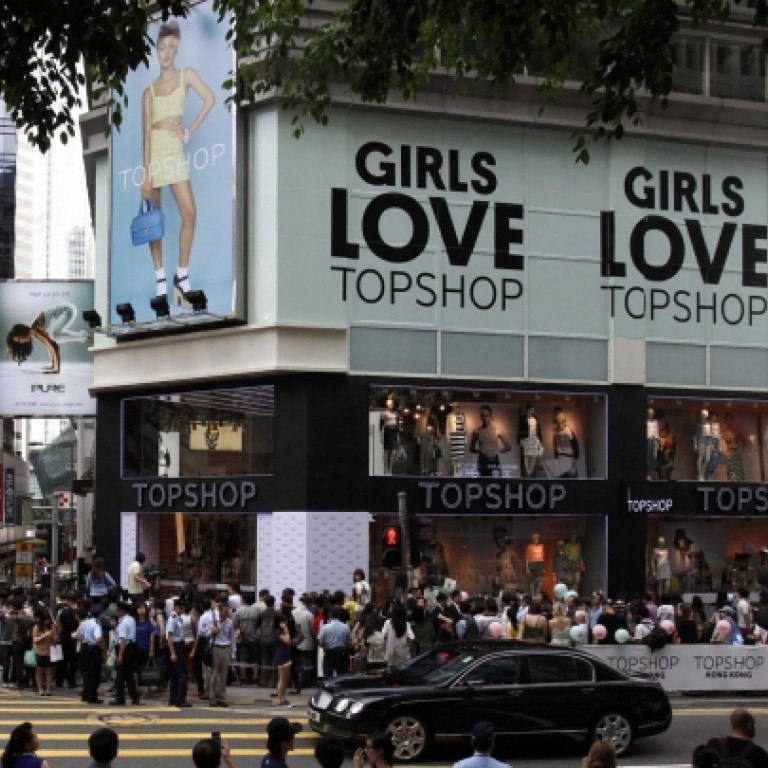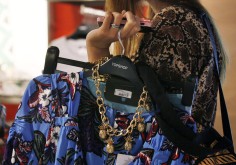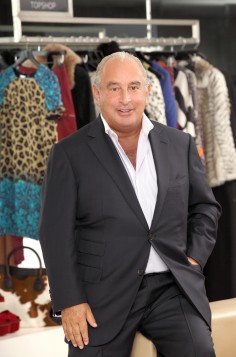
Sir Philip Green reveals Topshop's winning formula
With shoppers flocking to his first store in the city, Topshop tycoon Philip Green tells Abid Rahman why staying on trend is key
"Can someone turn down the air conditioning in here? It's far too cold for people to shop," says Philip Green to the army of Topshop staff getting ready for the 5pm grand opening more than two weeks ago. People had been queuing outside since 9.30am. Walking around his first Hong Kong store, checking racks, fixtures and fittings, Green is leaving nothing to chance. The billionaire retail impresario insists on being hands-on.
"I love it. You have to," says the knighted 61-year-old globetrotting Englishman of the high street fashion business that has been his life for almost 50 years. Topshop, the crown jewel of his Arcadia Group's retail empire (which includes BHS, Evans and Dorothy Perkins), has in the past decade become a fast fashion phenomenon.
Topshop's arrival in Hong Kong is part of a larger wave of mid-tier, high street retailers which have set up shop here in recent years, altering a retail landscape traditionally dominated by luxury brands at one high end and incredibly cheap, functional clothing at the other.
Gap, Abercrombie & Fitch, COS, Forever 21, American Eagle, Jack Wills and many more have opened their first stores in Hong Kong in the past two years, suggesting Hongkongers are looking for something in between.
These recent high street heavies have followed the very successful lead of the Inditex Group's brands, Zara, Massimo Dutti, Pull & Bear and Bershka, which have been in Hong Kong for many years. The team behind high street giant H&M, which also owns Monki and COS, have also been busy with expansion in the past three years. And let's not forget Australian chain Cotton On, which has been here since 2008.
I looked at real estate prices here years ago ... it's crazily expensive
The styles on offer in these stores varies from urbanite sophistication to glamour puss and fun loving teen, allowing for a varied customer base.
Green feels this march of the mid-priced chains is fuelled by a consumer desire for fast-changing and on-trend clothing. "Doing our homework here, we're in a fashion spot, there are people here who want to buy trend. Hong Kong has that 100 per cent," he says.
Focusing on affordable yet on-trend fashion and accessories, Topshop has an almost cult-like following outside its British base. However, the city had to wait behind Malaysia, the Philippines, Singapore and Russia before getting its first store this month.
"Why not now?" says Green to the first and most frequently asked question of why it has taken so long to come to Hong Kong. "I don't think it was about waiting, really. We've been doing a lot, we've opened in Australia, we've opened in Brazil. We've tried not to be 'vanity openers'. I looked at real estate prices here years ago, and it's crazily expensive, as it is in most big cities."
Green concedes the practical obstacles to opening a store melted away recently. "They [Lane Crawford] had the site. It was their lease," he adds, noting that his close friendship with Lane Crawford CEO Jennifer Woo helped move things along immensely.
As soon as the Topshop team had the green light they sprung into action and design; building and staffing was completed in just under 180 days.
Speed is the mantra at Topshop, with collections changing from week to week and the need to remain fresh its number one selling point.

This appetite for on-trend fashion has exploded in Hong Kong, fuelled by a growing mainland middle class coming over the border to shop at chains not yet available in their home cities. The likes of Topshop are filling the gap between low quality, unbranded and unfashionable cheap clothing and the often unobtainable luxury brands. Such high street shops offer the latest styles from catwalk trends at reasonable prices.
Green puts the popularity of high street fast fashion down to increased knowledge through magazines and the internet. "What we find is, trend is the trend. Because people have such easy access to know what's on trend and what isn't."
He admits there is enormous pressure to remain fresh but says Topshop is geared to keep one step ahead. "Each rack is monitored on a weekly basis. We analyse each one by size and by colour. The devil is in the data," he says.
All this information can lead to rapid changes. Clicking his fingers, Green says "we can react like that", adding that Topshop manufactures in 30 countries, so it can chop and change.

"If we do something new, it would be here. [There's] nothing at the moment, but we're always thinking of new ideas," he says.
The Hong Kong store is also one of the few in the world to offer a free by-appointment-only stylist service, and a Reclaim to Wear collection is also launched here - a global first where clothes are created from remnants and off-cuts to ensure little is wasted. Green would love to bring Topman to Hong Kong and, at present, is in talks about doing just that.
Green is looking across the border. He believes it will be easier for Topshop to enter the mainland after establishing itself in Hong Kong. But, again, it's about waiting for the right opportunity.
"I have lots of landlords coming to see me," says Green, recounting some of the more wild offers, he's received on the mainland, including one development in Nanjing.
"I went to see one developer who, in one province, had seven department stores, and they were building a new one, which he was showing me with his daughter. He said it was three million square feet.
"Now if you consider Macy's, the biggest store in the world, is one million, that's three million. The scale! So I said, 'What are we going to do with that sort of size?'"
But you also wouldn't bet against him finding a way to make it work.

